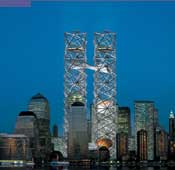|
After the six initial design proposals for rebuilding at Ground Zero were met with an overwhelmingly negative response from the public and critics alike in July 2002, the Lower Manhattan Development Corporation (LMDC) quickly changed gears and a month later invited architects from around the world to submit fresh ideas and plans for the site in what it termed the "Innovative Design Study."
The LMDC received 406 submissions from teams of architects around the world and, in September 2002, it chose six panelists to winnow down the list. The panelists -- Toshiko Mori, chair of the architecture department at the Harvard Design School; Eugenie Birch, chair of the city and regional planning department at the University of Pennsylvania; Richard Swett, architect and former congressman from New Hampshire; Kinshasha Holman Conwill, a New York City arts and management consultant; Terence Riley, chief architecture curator of the Museum of Modern Art; and Michael Van Valkenburgh, professor of landscape architecture at Harvard -- selected seven teams of architects, who offered nine different designs for the site.
In contrast to the reaction to the initial designs, the Innovative Design Study proposals were received with enthusiasm. A New York Post editorial written after the plans were released was headlined, "An Embarrassment of Riches," while a New York Daily News editorial opined that the plans were "overflowing with creativity and vision and raw emotion." The New York Times editorialized that "New York City received a gift of its kind it has almost never received before," and that the plans were "proud, bold and capable of helping us reimagine who we are in the wake of 9/11."
| 
 |